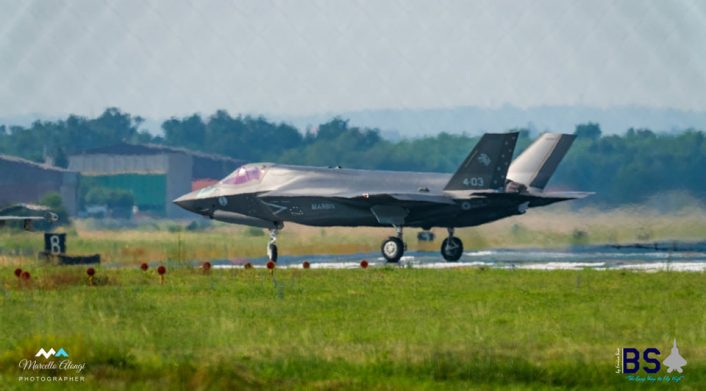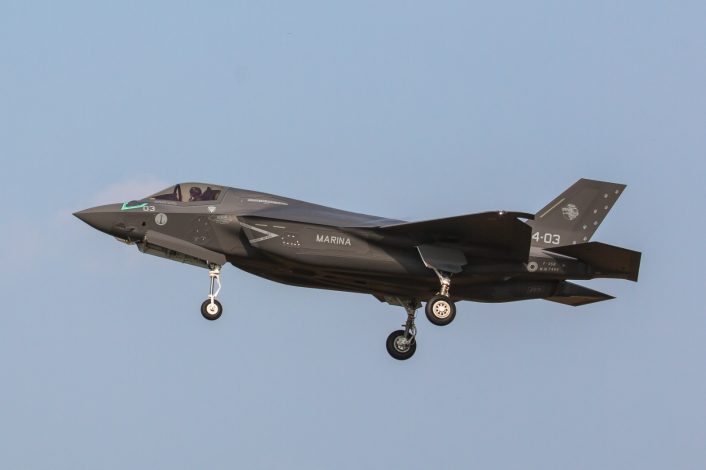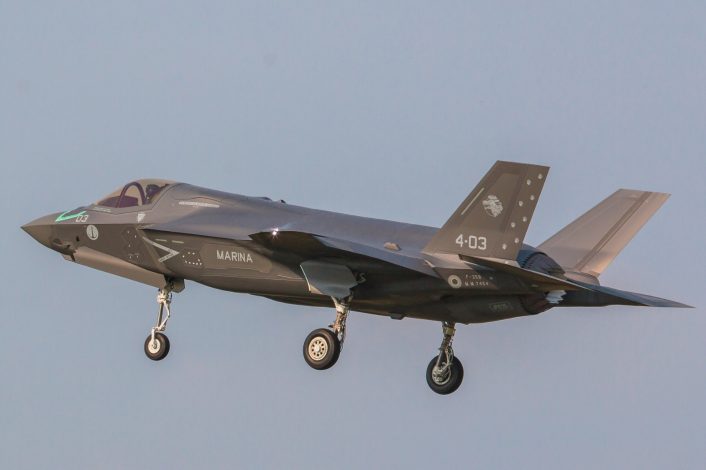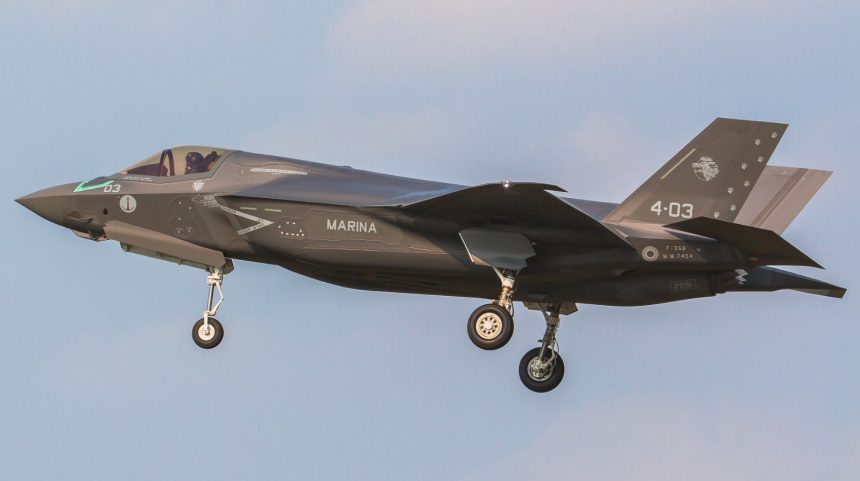BL-4 is the fourth Italian F-35B, the third STOVL aircraft destined to the Italian Navy.
On Jun. 14, 2021, the F-35B BL-4, the fourth STOVL (Short Take Off Vertical Landing) aircraft assembled in Italy, at the FACO (Final Assembly and Check Out) facility, in Cameri, carried out its maiden flight.
The aircraft, coded “4-03” and serialled MM7454, is the third aircraft destined to the Marina Militare (Italian Navy). The first two aircraft MM7451/4-01 and MM7452/4-02 are currently at MCAS Beaufort, South Carolina home of U.S. Marine Corps F-35B pilot training, where the Italian pilots destined to the STOVL variants are trained too.
BL-4 sports the same livery already adopted on the first two aircraft and clearly inspired to the one used by the Italian Navy’s AV-8B+ Harrier II of the Gruppo Aerei Imbarcati “Wolves”, based at Grottaglie: it features the wolf’s head insignia on the tail, the wolf’s paw prints on the rudder, the Italian Navy roundel and the “MARINA” text.

The images in this post were provided by our friends at BestShotAircraft and their photographers Roberto Resnigo and Marcello Alongi.
The aircraft has already carried out two test flights: the program calls for six test flights, including one in STOVL mode, before the jet is delivered to the customer for acceptance.

Where the aircraft is headed after being delivered to the Italian Navy is still not clear. Considered that two F-35Bs are already in the U.S., it seems quite likely that the third aircraft will remain in Italy, possibly becoming the first Italian Navy F-35 to land aboard Italy’s aircraft carrier ITS Cavour, the flagship of the Marina Militare, that has recently returned to Italy after successfully completing the “sea trials” for the operational use of the F-35B.
As often explained here at The Aviationist, the Italian Government is currently procuring 90 F-35s, 60 of those are F-35As and the remaining 30 ones are F-35Bs. Out of those 30 F-35Bs, 15 will go to the Navy and 15 to the Air Force. The Lightning II will replace the Navy’s ageing AV-8B+ Harrier II and will be embarked on the Cavour aircraft carrier and the new LHD Trieste. It is not completely clear, however, where the F-35s will be land-based.
This is what this Author wrote last year, commenting the news of the delivery of the first F-35B to the Air Force in February 2020:
The Gruppo Aerei Imbarcati, which will operate the F-35B within the Navy, is currently based in Grottaglie, close to the naval port of Taranto, home to the Cavour aircraft carrier [and to the Trieste landing helicopter dock (LHD), in the future]. However, according to some reports, the Italian Defense Chief of Staff has already identified Amendola Air Base, the MOB (Main Operating Base) of the F-35A within the ItAF (about 100NM northwest of Grottaglie), as the national MOB for both the CTOL (Convetional Take Off and Landing) and STOVL (Short Take Off Vertical Landing) versions of the Lightning II. This should prompt the relocation of the “Wolves” to Amendola, creating a joint Air Force/Navy flight line with common logistics and training, even though it would practically mean that the entire force would mostly be under Air Force control.
With both Italian Air Force’s and Navy’s F-35Bs based at Amendola AB, the Italians would replicate the British model that sees RAF Marham as MOB for a jointly manned “Lightning Force” made of Air Force (with the 207 and 617 squadrons) and Navy (with the 809 Naval Air Squadron that will be re-established in 2023) personnel, sharing aircraft, equipment and support infrastructures. The creation of an Italian Joint Lightning Force makes much sense: aircrew training, maintenance and at least part of the logistics could be concentrated in one place, with some significant savings. And if the selected base is Amendola, the Italian Joint Force could leverage at least some of the infrastructures built there to accommodate the Lightning. Indeed, preparation to host the F-35 in Amendola started in 2012 and today the “F-35 citadel” is literally a “base inside the base” with modern shelters and buildings located inside an access-controlled restricted zone created to isolate the 13° Gruppo’s area from the rest of the base. It must not be forgotten tha the advent of the F-35 has induced the Italian MoD to adopt tighter security measures than those in place before the arrival of a 5th generation technology and this becomes pretty evident if you think that all the photographs taken inside Amendola, must be reviewed one by one by security personnel so that no sensitive detail would be leaked. For sure, making Grottaglie ready for the F-35B would cost a lot of money and time, considered that the works to prepare the base for the Joint Strike Fighter were halted a couple of years ago.
In a post about the F-35B and the use of the aircraft as part of an Italian Joint Lightning Force published here at The Aviationist about 10 years ago our Editor David Cenciotti wrote:
“I don’t know if Italy is ready for a single type of aircraft for both ItAF and ItNy, capable of operating from the Cavour aircraft carrier as a single unit, something that would logically lead to the creation of a joint force similar to the British Joint Force Harrier and to the subsequent proposal of reabsorbing the unit into the Air Force, an option that the Navy might not accept….”
A decade later, the situation has probably not changed much.
In fact, while the final decision about the basing might still be uncertain, there is no doubt that the assignment of the third F-35B to the Air Force has made the Navy not happy. Navy officials have long challenged the decision of the Italian Air Force to procure the F-35B. The Italian Air Force considers the STOVL variant of the stealth aircraft indispensable for expeditionary scenarios and operations from unimproved and short landing strips.
But, does the Italian Air Force really need to trade such flexibility for a more expensive and complex airframe, with shorter maximum range, reduced flight envelope, external (in pod) gun? According to the Air Force planners and decision makers, yes: a worldwide survey of all the runways that can be used by military jet highlighted that the ratio, in Africa alone, was 1 to 10, that is, for each runway usable with conventional aircraft, there are ten shorter ones, that are only exploitable by STOVL aircraft.
Still, not everyone agrees, pointing out that within the U.S. military, the F-35B remains a prerogative of U.S. Marine Corps, that uses the type from its amphibious assault ships, while the U.S. Air Force, that is certainly involved in expeditionary operations much more than the ItAF will ever be, has never had the need to operate the STOVL-variant.
The former Italian Navy Chief of Staff, Adm. Luigi Binelli Mantelli wrote to the Defense Minister Lorenzo Guerini an open letter (published by La Stampa newspaper) illustrating all the cons of assigning the STOVL jets to the Italian Air Force. The view of the retired Admiral is that the procurement of the F-35B should be exclusive to the Marina Militare: he argues that the purchase of variant B by the Air Force is a mistake because this version would be expensive, with complex maintenance and with different operational limitations compared to the A version operated by the ItAF. On the other hand, the Admiral supports the indispensability of the F-35B for the Navy to operate from “light” aircraft carriers, advising to divert all the STOVL-models to the Marina Militare. The initial requirement of the Navy was for 22 F-35Bs. With just 15 jets, one might expect that no more than 8-10 F-35Bs will be available at any given time, a number that is deemed not sufficient for the needs of the Italian naval aviation.
While it’s now hard to believe the decision to give the Air Force some (or half) of the total F-35Bs will be reversed, the Navy at least wanted to receive most (if not all) of the first F-35Bs so as to continue the transition of its pilots and expedite the achievement of the IOC (Initial Operational Capability) with the new aircraft as the training required by the at-sea operations is far more complex than the one required for land-based operations. But the Italian MoD decided to give the Air Force its F-35B so that its pilots could start training on the new aircraft too. And Amendola, as explained above, has already been prepared to accommodate the new STOVL-models.
Whatever your opinion on this subject is (this is a much debated topic in Italy) it’s pretty evident that much more will have to be done to improve synergies between the two branches and make an Italian Joint Lightning Force a reality.
The situation remains more or less unchanged.
The Italian Navy carried has been declared ready to accept the F-35B while the Italian Air Force has taken continued to operate with its only B, that the service has presented to the public for the first time last year, during an Expeditionary Proof Of Concept on Pantelleria island. The same aircraft has been shown flying in “Beast Mode” alongside an A model and has recently returned to Pantelleria again earlier this month, along with a B model of the Royal Air Force embarked aboard the HMS Queen Elizabeth for an Expeditionary Combat Support Event (ECSE) conducted as part of the large Falcon Strike 2021 exercise.
“The Italian Air Force needs the F-35B to be able to operate from short runways, a capability we had in the 1960s with the G-91 and lost with its successor, the AMX,” told us Gen. Gianni Candotti, the Italian Air Force’s operational commander during the ECSE at Pantelleria. “The lack of such ability has caused us issues for quite a long time. When we deployed to Afghanistan [in 2008], we first had to find an alternate airbase [Mazar-i-Sharif] with a runway that was suitable for the Tornado, then we started working on the runway at the forward operating location that was hosting the Italian base [Herat] and, after one year, once we had extended the runway, we were eventually able to operate from there [with the AMX]. The F-35B would have allowed us to operate from there since the beginning. That being said, while it is possible, operating from aircraft carriers is not our immediate objective: that is not the reason why we have selected this kind of aircraft.”
Interestingly, considered the number of F-35Bs both the Air Force and Navy are getting, Candotti didn’t rule out the eventual joint command similar to the British one that’s being considered (at least among analysts). “Everything is possible. Our British colleagues did it with the Harrier and continue with the F-35B. There are various ways to integrate from minimum collaboration to full integration. It is being studied.”










